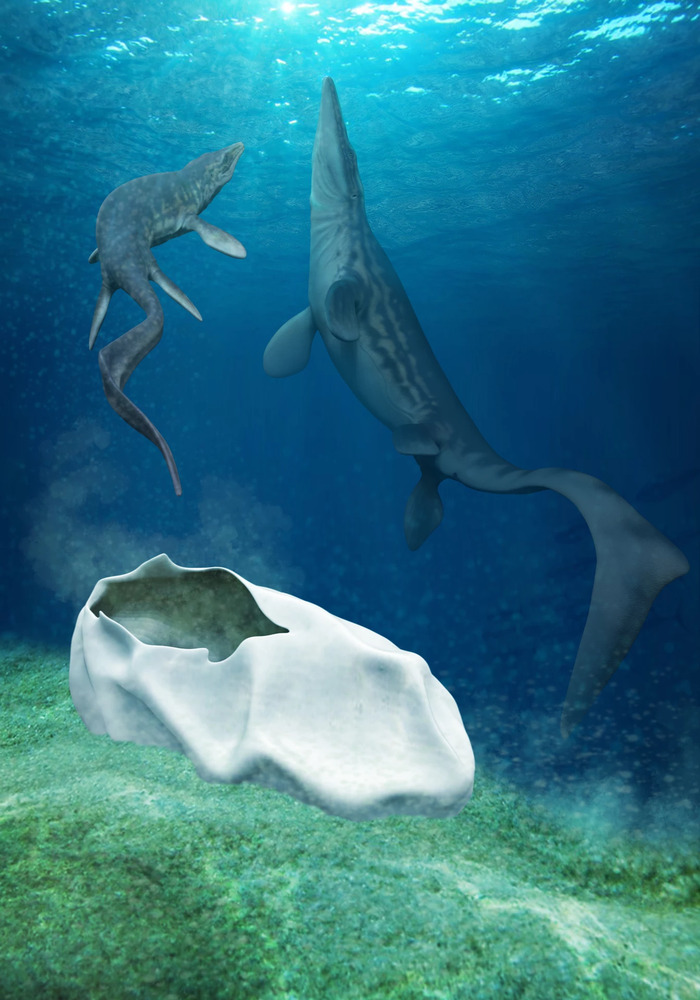PermeateFree said:
A strange fossil discovered in Antarctica almost a decade ago has finally been identified. Researchers at the University of Austin at Texas have determined that the object is a giant, soft-shell egg, most likely laid by an ancient marine reptile.
It looks like a squashed football, measuring over 11 in (27.9 cm) long and 7 in (17.8 cm) wide.

The fossil egg, which looks like a deflated football
But it’s not just any egg – this is the second-largest egg of any known animal, alive or dead, and the largest soft-shelled one ever seen. It dates back to about 66 million years ago – just before the dinosaurs became extinct.
The researchers came to this conclusion after comparing the relative body and egg sizes of 259 living reptiles. Judging by the size of this egg, the researchers calculated that the reptile that laid it must have been more than 23 ft (7 m) long – not including a tail.

A mosasaur fits the bill, both due to its size and its relation to living creatures that lay similar types of eggs. That’s backed up by the discovery of fossilized bones from baby and adult mosasaurs and plesiosaurs, found in the same Antarctic rock formation as the egg.
“Many authors have hypothesized that this was sort of a nursery site with shallow protected water, a cove environment where the young ones would have had a quiet setting to grow up,” says Legendre.
https://newatlas.com/science/giant-ancient-egg-antarctica-mosasaur/
A 2020 study published in Nature described a large fossilized egg from Antarctica that was laid and hatched towards the very end of the Cretaceous, about 68 million years ago. The egg is considered one of the largest amniote eggs ever known, rivalling that of the elephant bird, and due to its soft, thin, folded texture, it likely belonged to a marine animal. While the organism that laid it remains unknown, the egg’s pore structure is very similar to that of extant lepidosaurs such as lizards and snakes, and presence of mosasaur fossils nearby indicates that it may have been a mosasaur egg. It is unknown whether the egg was laid on land or in the water. The egg was assigned to the newly-described oospecies Antarcticoolithicus bradyi. Wiki
“The egg, discovered in 2011 and the first mosasaur egg ever found, is about a foot long. The only larger egg ever found came from the elephant bird. We didn’t think that soft-shelled eggs could grow that big without collapsing … There’s no embryo inside the egg, so it’s hard to say for sure what kind of animal it was from. But dozens of mosasaur fossils have been discovered in Antarctica”
> But there’s a problem: conventional thinking says that mosasaurs – and most other ancient, giant marine reptiles – gave birth to live young. More evidence will be required to figure out whether this egg really does show otherwise.
I’ve seen an ichthyosaur fossil giving birth to live young at the Natural History Museum in London. But there’s no way to extrapolate from that to egg-laying marine reptiles. Fish and reptiles gained and lost on many occasions the change from egg-laying to live young.
Also have a look at https://www.nytimes.com/2020/06/17/science/dinosaurs-soft-eggs.html
“There’s a problem with dinosaur eggs: A lot of them are missing. … A new study published Wednesday in Nature, showcasing baby dinosaur remains from Mongolia and Argentina, offers a reason: The very first dinosaurs laid soft eggs like turtles do today, and their eggs decomposed long before they could ever turn into fossils. In a second study also published in Nature, paleontologists announced the first known fossil egg found in Antarctica. The egg, also soft-shelled, looks like a deflated football. It’s bigger than any dinosaur egg ever found, and the team that unearthed it thinks it might be the egg of a mosasaur. Both studies scramble scientific understanding of ancient reptile reproduction.”
I don’t like calling them “reptiles”. Even mosasaurs are closer to birds than to squamates. But if both dinosaurs and squamates laid soft-shelled eggs then perhaps the relationship is closer than I thought.
“Dr. Norell was in Mongolia excavating dinosaur fossils in the Gobi Desert. There, he unearthed the fossil babies of a dinosaur called Protoceratops. The Protoceratops babies died sometime between 75 and 71 million years ago, and they’re curled in fetal positions. They look as if they should still be sheltering in their eggs. But there were no fossilized eggshell fragments. Instead, a thin film surrounded the animals. Paleontologists regularly unearth large hauls of dinosaur eggs at excavation sites. But these eggs were always younger than the middle of the Jurassic Period.”
“Ms. Wiemann analyzed the chemistry of hard and soft eggs from animals like chickens and turtles, and she found that each shell type produces a unique chemical fingerprint. She then looked at the chemistry of the Protoceratops films, as well as films from the egg of another dinosaur from Argentina called Mussaurus, and found that the dinosaur eggs matched the soft shell fingerprint. That was incredibly exciting. They realized that the common ancestor of all the dinosaurs must have laid soft eggs.”